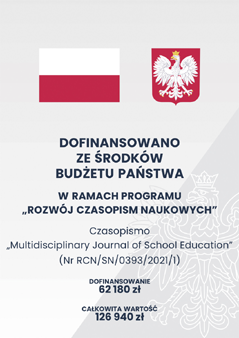Dimensions of Multicultural Education and Their Implications for Primary School Foreign Language Teaching
Abstract
In the context of contemporary reality, the issue of multicultural education is becoming more and more popular. Therefore, the purpose of the article is two-fold: to discuss Banks’ vve dimensions of multicultural education and to share some ideas on how these dimensions are or can be used to assist teachers in integrating multicultural content into their primary foreign language classrooms. Moreover, one section of the paper is devoted to the vgure of Professor James. A Banks, who is widely regarded as a founder of multicultural education. Moreover, the professor’s own rewections on the dimensions of interest expressed in the interview conducted by Tucker in 1998 are presented. Finally, having recognised the importance of early multicultural education, the author of the article concludes that primary foreign language teachers should not hesitate and encourages them to start preparing their students to become unbiased global citizens.References
Araujo L. and Strasser J., 2003, “Confronting prejudice in the early childhood classroom”. Kappa Delta Pi Record, 39 (4), pp. 178–182.
Banks A. J., 2001, “Multicultural Education: Its E*ects on Students’ Racial and Gender Role Attitudes.” In J. A. Banks and C. A. M. Banks (Eds.), Handbook of Research on Multicultural Education, pp. 617–627. San Francisco: Jossey-Bass.
Banks J. A., 1993, “Multicultural Education: Historical Development, Dimensions, and
Practice.” Review of Research in Education, Vol. 19, pp. 3–49.
Banks J. A., 1995, “Multicultural Education: Historical Development, Dimensions, and
Practice”. In J. A. Banks and C. A. M. Banks (Eds.), Handbook of Research on
Multicultural Education, pp. 3–24. New York: Macmillan.
Banks J. A., 1999, An Introduction to Multicultural Education (2nd ed.). Boston: Allyn
and Bacon.
Banks J. A., 2004, “Multicultural education: Historical Development, Dimensions, and
Practice”. In J. A Banks and C. A. M. Banks (Eds.), Handbook of Research on
Multicultural Education (2nd ed.), pp. 39–29. New York: Macmillan Publishing
Company.
Banks J. A., 2013, Multicultural Education: Goals and Dimensions. Center for Multicultural Education, College of Education, University of Washington, Seattle:
<http://education.washington.edu/cme/view.htm> (Accessed: 05.03.2013).
Banks J. A., and Banks C. A. M., 1993, Multicultural Education: Issues and Perspectives (2nd ed.), Boston: Allyn and Bacon.
Banks J. A., and Banks C. A. M., 1995, “Equity Pedagogy: An Essential Component of
Multicultural Education”. Theory into Practice, Vol. 34, No. 3, Culturally Relevant Teaching, pp. 152–158.
Banks J. A., and Tucker M., 1998, Multiculturalism's Five Dimensions, NEA Today Online: <http://www.learner.org/workshops/socialstudies/pdf/session3/3.Mul
ticulturalism.pdf> (Accessed: 05.03.2013).
Bulliviant B., 1993, “Culture: Its Nature and Meaning for Educators”, In J. A. Banks
and C. A. M. Banks (Eds.), Multicultural Education: Issues and Perspectives
(2nd ed.), pp. 29–47. Boston: Allyn and Bacon.
Center for Multicultural Education, College of Education, University of Washington, Seattle; Professor James A. Banks: <http://faculty.washington.edu/
jbanks/> (Accessed: 05.03.2013).
Crary E., 1992, “Talking about di#erences children notice”, In E. Neugebauer (Ed.),
Alike and di#erent: Exploring our humanity with young children. Washington,
DC: National Association for the Education of Young Children.
Derman-Sparks L., 1989, Anti-bias curriculum: Tools for empowering young children.
Washington, DC: National Association for the Education of Young Children.
Kelly P., 2005, Multicultural education leader James A. Banks to give 29th Annual Faculty Lecture. UW Today: <http://www.washington.edu/news/2005/02/24/
multicultural-education-leader-james-a-banks-to-give-29th-annualfaculty-lecture/> (Accessed: 05.03.2013).
National Association of Multicultural Education: <http://nameorg.org/> (Accessed: 05.03.2013)
Ogletree Q. and Larke P. J., 2010, “Implementing Multicultural Practices in Early Childhood Education”. National Forum of Multicultural Issues Journal, vol. 7, no 1
Purnell P. G., Ali P., Begum N. & Carter M., 2007, “Windows, bridges, and mirrors:
Building culturally responsive early childhood classrooms through the integration of
literacy and the arts”. Early Childhood Education Journal, 34(6), pp. 419–424
Ramsey P. G., 2008, “Children's responses to di#erences”. NHSA Dialog, 114 (4),
pp. 225–237
Copyright (c) 2013 Werona Król

This work is licensed under a Creative Commons Attribution-NoDerivatives 4.0 International License.
- The Author/Authors agree(s) to publish the article free of charge in Multidisciplinary Journal of School Education in English or Spanish. The Editorial Board reserves the right to shorten the texts and change the titles.
- As part of free publication mentioned in § 1, the Author/Authors agrees to make the full electronic version of their article available in the Internet.
- The Author/Authors agrees to index their article in databases at home and abroad, including abstracts and keywords as well as Author's/Authors’ affiliation in English and in other languages. The Author/Authors agrees to pass on the information mentioned above to the owners of these databases.
- The Author/Authors declares that their publication is original and does not include borrowings from other works which might cause Publisher's responsibility, does not infringe the rights of the third party and that their copyright on this publication is not limited. The Author/Authors will incur all the costs and will pay compensations which might result from the mendacity of the following statement.
- The Author/Authors declares to bear complete responsibility for the scientific reliability of the article submitted. The detailed contribution of all co-authors is defined.
- The Author/Authors declares to publish the text in the Multidisciplinary Journal of School Education under a Creative Commons Attribution-NoDerivatives 4.0 International License (CC BY-ND 4.0).
- For more than one author, please complete the Authorship Contributions and send it to the editorial office. Please indicate the specific contributions made by each author (list the authors’ initials, e.g., JKH). Please download, complete, scan and attach the file in the system during the submission process.
Authors Statement - Authorship Contributions






